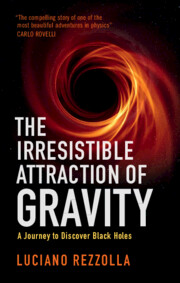As I have already discussed, the title of this chapter is meant to be less trivial than it might seem.
Here, I do not want to simply stress the existence of a physical ‘force’ exerted between two objects with a mass, which attracts them to each other even if they are at a great distance. Indeed, in Chapter 3, we will discover that this idea, however widespread and easy to understand, is incorrect and, at least in part, misleading. Rather, with this title, I wish to emphasise that there is something – gravity – that attracts us in a broad sense and, above all, attracts our attention. In addition to physical objects, it applies an irresistible grip on our imagination; it can push our thoughts towards radically new horizons, different from the usual ones, and expose us to scenarios that extend far beyond our everyday experience.
But let’s proceed step by step. To better define what gravity is, it helps to break down the knowledge we have into three distinct but interconnected levels. In particular, we could say that we have: instinctive knowledge, rational knowledge and, finally, an imaginative knowledge of gravity.
Let’s see what they are and how they differ from each other.
Instinctive Knowledge
We all know that instinct is the natural and intrinsic tendency (that is to say, not requiring the intervention of reasoning or reflection) to carry out a particular behaviour. An example of instinct would be what drives us to flinch to protect our heads when we are surprised by a sudden, loud and unknown sound. When put in these terms, it is difficult to believe that something instinctive or irrational can possibly bind us to gravity. Yet it is so.
Anyone who has handled a newborn will surely have seen first-hand the so-called Moro reflex, named after the Austrian paediatrician Ernst Moro (1874–1951). It is one of the main neonatal reflexes and is widely used in evaluating the function of the central nervous system. To induce this reflex, it is sufficient to take a newborn, even in the first few seconds after birth, lift it in a horizontal position and (making sure it is totally safe) create the sensation of a free fall! The newborn’s response to the unexpected and apparent loss of support is a reaction of surprise, accompanied by the sudden opening of the arms and hands in search of a handhold, as is shown in Figure 1.1.

Fig. 1.1 Example of the Moro reflex: a newborn reacts instinctively to the loss of support, spreading her arms and trying to grab a handhold to stop her fall.
From a medical point of view, the appearance of this reflex is important evidence of the perfect physiological functioning of the infant’s central nervous system. That is why we have all been subjected to this test. Any parent who has attended – this has happened to me three times – is well aware of the relief they felt on seeing their son or daughter respond as they should to this rather bizarre stimulus.
On an anthropological level, the Moro reflex reminds us of our past as primates, when in all probability we had to be immediately ready to follow our mothers, holding on firmly to their backs. However, what interests us most here is its physical significance. The presence of this instinct a few seconds after birth (when we are completely defenceless and know nothing about the world around us) reveals an important truth concerning our interaction with gravity: we know it instinctively, well before having conscious interactions with the rest of the physical universe. Thus, after having spent nine comfortable months in our mothers’ wombs, essentially isolated from everything, we are immediately able to respond to gravity (or rather, to its absence). This is no small detail.
The Moro reflex disappears at around six months, so our knowledge of gravity, while remaining partly instinctive, changes over time as we develop the ability to observe the physical universe and understand its laws.
Rational Knowledge
As our experience of the world expands and our intellectual abilities are refined, our knowledge of gravity changes from an instinctive level to a rational one. In other words, it becomes an integral part of our expectations of how the world around us functions. This is clearly demonstrated through simple visual experiments conducted on very young children using cartoons. Although some of the subjects involved are not yet able to walk, all of them can interpret the motion of an object that is consistent with the presence of a gravitational field. The classic example is that of a sphere rolling on a table: children react differently (at the level of facial expressions and eye movements) depending on whether the sphere, once it reaches the edge of the table, falls, or continues its motion despite being without support or, even more bizarrely, if it begins to fly. The fact that the infants know what the correct behaviour of the ball should be is further confirmation of how deeply the knowledge of the ‘force’ of gravity is rooted in our minds.
This plays a fundamental role in our rational perception of reality. Thanks to this profound influence, our brains are able to solve very complex dynamic problems in a very short time and with practically no effort. A simple example is the action of hurrying down a flight of stairs: it is one of the most complex problems when programming robots (and one at which they often fail); however, we humans can cope without even consciously thinking about it. Yet, establishing in what sequence and at what speed our movements must be performed to ensure the subtle balance between the various forces competing with the gravitational force, is by no means trivial.
Finally, another property of gravity is worth pondering: its ability to stimulate our imagination.
Imaginative Knowledge
If it is clear that we have an instinctive and rational notion of gravity, then in my opinion it is equally clear that gravity also exerts an irresistible attraction on our imagination. It is precisely because we are immersed and subjected to a gravitational field every instant of our lives that we are naturally fascinated by those scenarios in which gravity is weak or even absent. Who has never wished they could jump off a high cliff or a mountain top and … fly? Who has never imagined being an astronaut aboard the International Space Station or a character in a science-fiction movie floating effortlessly from one place to another in zero gravity? I often do …. In other words, gravity attracts our attention. It stimulates our imagination precisely because it is the only fundamental ‘force’ of which we have a conscious awareness and because we know all too well how difficult it is to escape it. What, if not imagination, led first Isaac Newton and then Albert Einstein to explain (in very different ways) the laws that govern gravity?
There are many examples that illustrate the powerful pull of gravity on our imagination, but I will limit myself to just one, which I find representative and easy to understand. In 2013, the Spanish director Alfonso Cuarón made a movie with the emblematic title: Gravity. For almost two hours, the film talks about nothing other than gravity; or rather, its absence. However, not many know that Gravity broke the box office record for the first weekend screening of the films released that autumn. Some may argue that this success is entirely due to the leading actors, the two Hollywood superstars Sandra Bullock and George Clooney. In my opinion, however, a fundamental role has been played by the fact that – like it or not – we cannot escape gravity and its irresistible pull on our minds.
One of Four, but Definitely Different from the Others
The considerations made so far provide an excellent starting point for introducing another important reflection on gravity’s role within our understanding of nature. Modern physics teaches us that there are four types of fundamental interactions, which essentially describe all the processes taking place in the universe: the electromagnetic interaction, the strong interaction, the weak interaction and the gravitational interaction.
The first, the electromagnetic interaction, among other things, allows you to read this book regardless of the format you are using. In fact, electromagnetic waves (photons or, more simply, light) emanate from the page in front of you and reach your eyes. These waves then convert into electrical signals transmitted via the optic nerve to the brain, which (thanks to a complex combination of electrical and chemical exchanges) translates them into the words you are reading. The electromagnetic interaction is also responsible for the cohesion and dynamics of the molecules that compose us. Without it, we would not even exist as human beings, and our molecules would scatter like bits of paper in the wind. The theory that describes the electromagnetic interaction is well known, both at the level of classical physics (where it is expressed by the Maxwell equations) and at the level of quantum physics when dealing with elementary particles (where it is also known as theory of quantum electrodynamics).
The second, the strong interaction, develops instead on the smallest scale accessible to us in nature, of the order of a few fermi (or femtometres), that is, a few thousandths of a billionth of a millimetre. The strong interaction is a hundred times more intense than the electromagnetic interaction and is exerted between quarks, the constituent parts of elementary particles such as protons or neutrons. In reality, this interaction is also present on slightly larger scales, that is, inside atomic nuclei (which generally have dimensions of the order of 10 fermi), where it takes the name of the strong nuclear force. In the case of protons and neutrons, the mediating particles of the strong interaction are called gluons, while in the strong nuclear force they are represented by the pions. In essence, the strong interaction acts as the ‘glue’ that holds the atomic nuclei together, from the smallest atoms (hydrogen) to the larger ones (for example, uranium). It also regulates what happens when two protons smash against each other at a speed almost equal to that of light or when a neutron star is born (a phenomenon we will discuss in detail in Chapter 5). The theory that describes this interaction is well developed and is called quantum chromodynamics. Unfortunately, given the complexity of the theory and the equations that describe it, it is often difficult to make precise predictions, especially if the energies are high or if the number of particles involved is large, as in the case of neutron stars.
The third, the weak interaction, is responsible for the radioactive decay of some atomic nuclei and acts between leptons (a class of particles to which electrons, certainly the most ‘familiar’ of the group, belong) and quarks. It is thanks to this interaction that neutrinos (very light particles produced by matter of high density and temperature, such as those at the centre of the Sun) interact only rarely (‘weakly’) with protons and neutrons, the ordinary matter of which we are composed. It is good to recall that, at this precise moment, our bodies are crossed by billions of neutrinos emitted about eight minutes ago by the Sun and which travelled to us at almost the speed of light. If we do not ‘feel’ pierced by these particles, it is precisely because they interact only weakly with the ordinary (or hadronic) matter of which we are made. In other words, there is little to worry about; we are essentially transparent to neutrinos. The theory that describes the weak interaction is also very well developed and can be combined with that of electromagnetism, so in that case we refer to it as the electroweak interaction.
So, finally, we arrive at the fourth, the gravitational interaction. Although it is not yet the time to explain in detail what it consists of and how it links to one of the most subtle and elegant concepts of theoretical physics – the curvature of spacetime – we can already reflect on what distinguishes it from the others. Gravity is the only physical interaction of which we are consciously aware. The only one whose influence on your body you are aware of at this moment, as you read this book. In fact, whether you are lying on a bed, slumped in an armchair or standing, you know that some ‘force’ affects your position. Without it, you would levitate, floating freely just like an astronaut on the International Space Station.
This point is essential in order to fully understand the title of the chapter and grasp its deeper meaning: gravity attracts our attention because we can directly and tangibly experience its existence, unlike other fundamental interactions. By contrast, we cannot appreciate the level of cohesion of the molecules that make up our bodies, how rarely we interact with a neutrino or how many radioactive particles we emit.1
The fact that we can experience it directly and consciously is enough to give gravity a special place among the fundamental interactions and, in my opinion, places it above all others. What makes it even more peculiar is that this awareness accompanies us in every second of our lives, even before coming into the world. Subconsciously, we are aware of the presence of gravity long before grazing our knees when we learn to walk and run, and certainly before we encounter the laws of physics in school or college.
But What Is Gravity, and How Does It Work?
In all likelihood, many of you feel convinced you can provide a reasonable answer to the simple questions: ‘What is gravity?’ and ‘How does it work?’. This is because you know it both instinctively and rationally, and (either at school or university) you have been given an ‘educated’ explanation for it. However, it is equally likely that the explanations given to you are not entirely correct, even if they are not completely far-fetched either. What I mean is that what you have been told or taught isn’t really wrong, but it’s not right either.
The reason for this apparent contradiction is that it is possible to understand gravity on various levels. For example, the representation of gravity proposed by Newton is simpler and more intuitive, which involves the existence of a gravitational force and whose mathematical description is relatively simple. At the same time, a different and deeper understanding is possible: the one suggested by Einstein, which implies a geometric vision of space and time and a much more complex mathematical description.
In the following chapters, a sort of evolution awaits us; we will develop our understanding of gravity. The first stage of this evolution – and therefore the first destination of our virtual journey – will take us from the basic understanding of gravity as it is encoded in our brains, even on an instinctive level, to the description provided by Newton’s theory. The second stage – or the next destination of the journey – will instead lead us to the mathematically compact and physically profound description Einstein proposed with his theory of general relativity, elegantly embodied in his field equations.
Thus, we will learn to connect what we know and experience on our planet, where gravitational fields are very weak, to what we observe in the universe, where enormously stronger gravitational fields give life to marvellous phenomena such as black holes, neutron stars and gravitational waves. In this way, we will find that our knowledge and understanding of gravity is strongly influenced by the way it manifests itself on this planet. However, we will also realise that we have to abandon such a view because it is wrong and because the constraints it sets on our imagination are too tight.
All in all, the correct answer to the questions posed above will be clear: ‘Gravity is simply the manifestation of the curvature of spacetime’. At the moment, this statement is still cryptic, I know. But, as mentioned in the introduction, a certain amount of patience is needed to embark on the journey that awaits us. I can assure you that it will all become much clearer by the end of Chapter 3.




